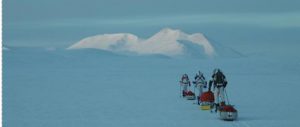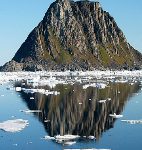After the cold room, the three Arctic explorers have more chilling work to do at the Institute of Naval Medicine in Portsmouth, England. As well as walking on their Arctic research trip, the team expects to swim for up to 100 hours, dragging their specially designed sleds over “leads” – stretches of water that can open up between ice pans, or small floes. While swimming, they will wear bright-orange immersion suits, which they now put on, lowering themselves into the pool of icy water.
Pen Hadow, the team leader, says it’s like being “shrink-wrapped”. I tried it for myself and it was how I imagined it would feel to swim in mercury. The pool temperature is much warmer than the cold room, 4º Celsius, but because water conducts heat 26 times better than air, it “rips” the heat away from the explorers. The final test is to get back into the water in only their walking clothes to simulate what would happen if they fell through the ice. If they do, the water is likely to be even colder, probably below zero Celsius — salt water freezes at -1.8° Celsius.
Early polar explorations left a trail of graves — men killed by hypothermia, scurvy, gangrene and even poisoning after eating the livers of polar bears. Modern science has alerted those who have followed to many of these dangers, and provided remedies. But for all the advances in modern technology, many risks still remain, almost all of them bound up in the landscape over which the team will have to walk and swim.
“Your brain is so used to visual information pouring in that when you go there the instant impression is: there isn’t anything up here – it’s all white,” says Hadow. In the first few days, the brain “retunes”, and as the other senses are dulled by the cold and the heavy layers of clothing, the eyes become more alert.
“Some people talk about the Arctic as a monotonous wilderness of white, but if you open your eyes and look at the landscape, especially in spring, you realise that there are no whites whatsoever,” writes Hadow in his autobiography, Solo. “Everything is in shades and tones of pastel colours — cream, grey, blue, green, yellow, orange, pink — and only in the stark bright light at the height of the polar summer, when the sun is high in the sky, do you begin to see true whites among the other colours.”
Nor is the Arctic a great flat glass to glide over. Before each trip, Hadow spends hours on Dartmoor – an area of moorland in south-western England — pulling strings of tyres around tors – rocky peaks — getting caught on and under rocks, untangling, pulling, shoving and scrabbling over cold wet granite to prepare for the huge pressure ridges he will have to clamber over: steep walls of frozen, slippery ice rubble that test both his physical strength and patience. Even on the “flat” pans, the ice is “rough, cracked, pitted and pocked with holes, lumps, bumps, projections and cracks where your burden becomes wedged or threatens to topple over, spilling its load,” he writes.
Then there are the wind and currents, which constantly work on the great floating, constantly changing landscape — grinding ice together, pulling pans apart, sometimes so “rapid as to equal a ship running before the wind”, to cite the evocative description of the ancient, unknown Norse writer of Kongespeilet. Not infrequently, travellers have to make huge detours or backtrack over a ridge or rubble field because of an impassable lead; occasionally they wake to find they have drifted south of the point they began walking the previous day. And the sounds of all this movement are amplified by the otherwise silent emptiness. The landscape is so empty that in 2003 Hadow recorded that the only life he encountered were three seals, one snow bunting and the tracks of a single polar bear.
By day, the whooshing of skis and scratching of poles and the roar of wind past their ears dominate the explorers’ world. At night, however, after the cooker is turned off, they lie with their heads on the ice and listen to it. “You wouldn’t conceive such random movements could produce such metronomic sounds: you get this der-der-der-der-der-errrr, der-der-der-der-der-errrr,” says Hadow. “It’s disconcerting because it tends to be the ice breaking up around your tent, often literally around you. This happens three or four times in an expedition. You have to take a view: will this open up and will we be falling in in the morning, or will it be little hairline cracks rather than major fractures?” Sometimes the wind also beats against the tent like a drum.
Today, the biggest threats Arctic explorers face are those things that happen quickly, before help can be summoned from a few hours’ away, or possibly days if the weather is bad. There is the moment-to-moment threat of falling through the ice — a risk that rises with every year the ice recedes. There are the constant dangers of being crushed by sleds, a sudden serious illness and always the fear of a polar-bear attack. Then there’s the nightly gamble with carbon-monoxide poisoning from burning stoves inside tents.
And all the time, of course, there is the ever-present, grinding cold. In temperatures as low as -50º Celsius, with wind chill that can sink to -90° Celsius, cold remains a constant danger. Travellers cannot stop for more than 10 minutes to mend equipment or they start to freeze — mucus dries like gravel in the nose, contact lenses would freeze to eyeballs, unprotected parts of the body can be frostbitten before you have noticed, fillings in teeth expand and contract, sweat freezes under clothes and, as the temperature drops, the human brain begins to slow, making people less responsive to problems — in extreme cases causing them to make the problem worse by acting in exactly the wrong way, such as undressing.
The constant struggle over the ice, the stress and cold are compounded by exhaustion. To keep their sled weight down, the explorers calculate they can survive on a “deficit” of about 1,500 to 2,000 calories a day, but after two weeks their bodies start to consume muscle to keep going. And, despite their exertions, sleep is often hard.
“For the first month you’re cold every night, shivering,” says Hadow’s colleague, Martin Hartley, “then you worry about polar bears sniffing around looking for a canapé in a sleeping bag.”
To cope with such conditions, Hadow adopts an almost obsessive regime of walking, eating from his “nosebag” of chocolate and nut rations, and checking his condition and his kit regularly. In a team, some risks are mitigated by having other people to help. But this time they will carry much more weight because of the measuring work and Hartley’s cameras and video equipment, and the trio also has taken advice from a psychologist about how to cope with personality problems that might arise.
Despite all these reasons, getting to the North Pole is still “85% in your head”, says Hadow. “Over the 70-odd days I was there last time [on his solo trip], I would only think there was less than half a day when all things were good.”
“It messes with your mind,” he says in another conversation. “The Arctic is a dynamic surface, and there are all sorts of things that can go against you. It feels like you’re against a mightier force, which is a disastrous way to reach your goal. It’s like a white crucible. You put yourself or your team in and apply a Bunsen burner to the crucible, and all the fluff and juices are evaporated off and you’re just left with the essence of those people."
For these reasons and the added difficulties of dragging extra weight, having additional tasks, raising many times the usual cost of a polar expedition, and — ironically — the worsening ice conditions, Hadow admits they cannot guarantee success. His own training also has been interrupted by one of the many viruses which gripped the United Kingdom this winter. “We cannot know whether we can do it,” he says. “But we’re not just giving it a go – we’re very locked on to going the distance, to 90 degrees [north]."
All being well, on February 24 or 25, the Catlin survey team will leave the base at Resolute Bay in northern Canada, be flown up to 80°N 140°W, where the multi-year ice begins, and start walking north-east along the line of 140° longitude. There can be no maps of ephemeral sea ice, and Hadow believes that the route has not been taken for 40 years, since the journey of Sir Wally Herbert, after whose wife, Marie, Hadow has named his sled.
As they travel across the ice pans, a radar device specially designed for the conditions, weighing just four kilogrammes, will take a measurement every 10 centimetres. The team also will stop regularly to drill cores of snow and ice and take measurements of the ocean temperatures and currents below. As they travel, Hadow will dictate notes into a special voice recorder about the regularity and make-up of ridges and other features. And Hartley, an award-winning photographer of difficult environments, will capture their progress and the landscape.
The data will be fed back via satellites to the scientists every night, and they hope that early results will be available before a United Nations meeting (COP15) in Copenhagen, Denmark. There, in December, the world’s governments will be asked to agree an ambitious treaty to cut greenhouse-gas emissions and so, it is hoped, reduce global warming and the resulting climate change.
“Once they have a figure for how long the Arctic sea ice will be there for, they will have to act,” says Hartley.
Scientists already believe that melting ice is responsible for average air temperatures warming twice as fast in the Arctic as in the rest of the planet. So far they believe the melting of the floating ice has an undetectable effect on global sea levels and the expansion of the warming water contributes less than 1% of the annual average rise. But if the ice melts further, or disappears, that cycle of melting and warming will add noticeably to sea levels.
There are emerging concerns that the warming water temperatures are speeding up the melting of the Greenland ice cap, which could add metres to sea levels. Less certainly, the influx of fresh and warmer water could start to alter the planetary circulation of ocean currents and winds that dictate weather patterns.
At the extreme, this could trigger one of the more catastrophic “tipping points” of climate change — the switching-off of the “thermohaline circulation” that brings warm water from the Tropics to the northern Atlantic and sends cooler Arctic waters south. In the impeccably bureaucratic language required to achieve consensus among hundreds of scientists and governments, the latest UN Intergovernmental Panel on Climate Change (IPCC) report described such an abrupt transition as a “low-confidence” event — that is, a two in 10 chance.
At best, the Arctic survey team’s science adviser, Wieslaw Maslowski, does not believe the results will give them more than a decade beyond his 2013 projection of the end of all Arctic summer ice. What then? Is it not too late?
“Even if it’s too late to do anything about sea ice, what other wildernesses are we going to let go?” adds Hadow.
Follow the expedition team — with regular updates on the explorers’ progress, physical condition and more — at www.catlinarcticsurvey.com
www.guardian.co.uk
Copyright Guardian News and Media Limited 2009
Homepage photo by Catlin Arctic Survey



